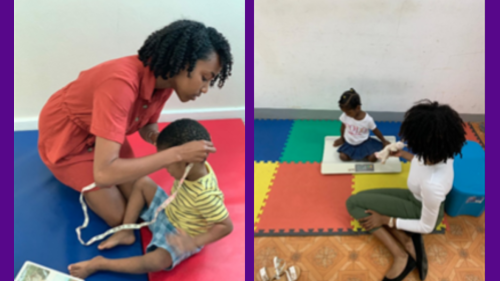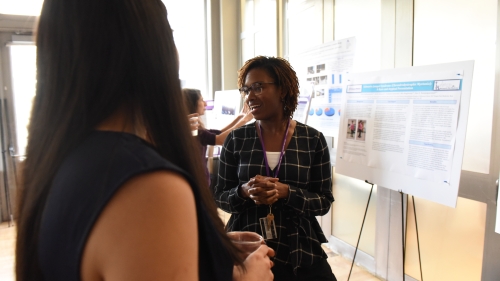We sat down with former Steinhardt Provost’s Fellow and Communicative Sciences and Disorders adjunct faculty Keisha Lindsay to discuss her research on the 2016 Zika epidemic and the expertise speech-language pathologists (SLPs) can lend to global public health issues.
Although the Zika (ZIKV) epidemic affected 84 countries, research on the developmental trajectories of children with confirmed or suspected prenatal exposure to the virus is limited.
“As a researcher, I am deeply committed to creating knowledge about individuals, groups, and communities that we have not yet described in the scholarship of our field,” said Dr. Keisha Lindsay, who is researching the effects of ZIKV on child development in an investigation taking place on the Eastern Caribbean island of Saint Lucia.
Unlike many other nations in the Caribbean region, Saint Lucia has a national referral system for children who are at risk for or confirmed to have developmental delays. Using this system, healthcare providers and early childhood practitioners throughout the island nation refer families with children who require monitoring, evaluation, and intervention to the Child Developmental and Guidance Centre (CDGC), a non-governmental organization that has become part of the healthcare system in Saint Lucia over the past 20 years.
Given that ZIKV has been noted to cause congenital abnormalities, Saint Lucia instituted additional protocols during the 2016 epidemic, including laboratory testing for pregnant women who presented to medical facilities on the island as well as monitoring and evaluating babies born during that time. With an influx of referrals and limited existing research on the long-term effects of in utero ZIKV exposure, CDGC’s Director and Paediatrician, Dr. Kim Gardner, assembled a team of researchers and practitioners from various fields.

The team's research assistant, Mya Peter, working with children in the cohort.
Noting growing concerns surrounding the speech, language, and swallowing skills exhibited by children in this ZIKV cohort, Dr. Gardner contacted Dr. Lindsay, who has also served as a volunteer speech-language pathologist in Saint Lucia for the past seven years. Their team also includes Elaine Clement, CDGC’s neurodevelopmental physiotherapist, and Mya Peter, the team’s research assistant. With additional input from colleagues at NYU and other institutions, the research team began designing a culturally- and linguistically-responsive longitudinal study that aims to investigate overall neurodevelopment in a growing cohort of children affected by ZIKV in Saint Lucia.
“First and foremost, CDGC is a clinical setting where children and families come to receive care,” said Dr. Lindsay. “We needed to tailor our research methodology and materials to their needs and concerns rather than pursue our curiosities as researchers.” As a result, many aspects of the data collection processes were designed in a way that they could be completed during a regular clinical visit to the center.
With the methodology in place, the research team has been collecting data on the gross motor, fine motor, speech, language, and swallowing skills of the children in the cohort who have been placed into three clinical groups:
- Children born with microcephaly (a ZIKV-associated condition in which an infant’s head is smaller than normal, often causing neurological issues);
- Children born without microcephaly to mothers who tested positive for ZIKV while pregnant;
- Children born without microcephaly to mothers who were not tested for ZIKV while pregnant but reported ZIKV symptoms.
“Microcephaly is a part of the classic congenital Zika syndrome or CZS, but many children who are exposed to ZIKV do not present this way,” Dr. Lindsay explained. “We are particularly interested in describing the developmental skills exhibited by children who present as typically-developing at birth but who demonstrate neurodevelopmental delays as they age.”
While the study is ongoing, initial patterns have emerged after two years of data collection.

Dr. Lindsay presented initial findings on the feeding and swallowing characteristics of children in the cohort at the NYU Center of Health and Rehabilitative Research (CoHRR) showcase as well as the American Speech-Language-Hearing Association's latest national convention.
“The group with CZS [with microcephaly] has immediate delays across the board—in motor, speech, language, and swallowing skills—and that’s what we expected. However, we did not expect to see delays in the group of children without microcephaly who were assumed to be typically-developing at birth. In this group, we are noting particular delays in the receptive and expressive skill domains.”
Dr. Lindsay and her colleagues plan on following the cohort of children at least until the age of five when they transition from CDGC to the public educational system in Saint Lucia.
“We know that the developmental delays we are seeing now will likely have long-term educational and social implications for these children and their families,” she said. “I believe that even our initial results offer local and regional health and educational systems an important preview of what is to come as children with confirmed or suspected prenatal exposure to ZIKV approach the age of schooling, not only in Saint Lucia but across the region.”
Dr. Lindsay notes that the emergence of speech and language delays is particularly critical to plan for because many countries in the Caribbean have few or no resident allied healthcare providers such as speech-language pathologists and audiologists. “Our research findings speak to the need to develop these fields in sustainable ways in the region,” she said.
Additionally, Dr. Lindsay believes that this interdisciplinary research project provides an opportunity to shed light on the important role of speech-language pathologists in public health research. “This project has opened my eyes to the need for allied health providers to be involved in research that addresses public health concerns, and I hope it is a model of how SLPs can bring our specialties and unique lens to projects that focus on the lasting effects of viruses such as ZIKV, and now, COVID-19.”
While COVID-19 has caused the research team to re-evaluate their goals for this year, Dr. Gardner and Dr. Lindsay maintain a positive outlook. “COVID-19 may limit some of our in-person research activities but we hope to continue seeing our children and families and supporting them via telepractice during this time.”
